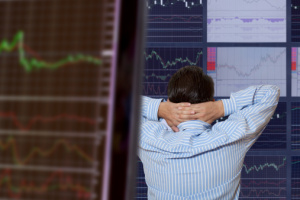 Watching the Olympics this month, it’s very clear that the people who succeed are the people who put a huge amount of pressure and expectation on themselves.
Watching the Olympics this month, it’s very clear that the people who succeed are the people who put a huge amount of pressure and expectation on themselves.
Success doesn’t come through luck, or cruising to victory (however easy Usain Bolt might make it look). Instead, it comes from hard work and being downright tough on yourself.
Which is why I decided it was time to suck it up and give myself an annual appraisal!
Surely it should be one of the benefits of working for myself that I don’t have to go through the torturous process of an appraisal? However, sitting alone in front of my trading screens, with no boss breathing down my neck, telling me to keep my expenses under control, it’s very easy to pick up bad habits.
So, here goes…
The bottom line
It might be simplest to start of my appraisal by looking at my “mental approach”. But that’s really just glossing over the most important bit – the big P&L figure.
Many traders would rather walk over hot coals that come to grips with their annual return. There are many ways to avoid the issue – like repeatedly topping up your trading account, so you don’t have to look at a negative number. Or failing to close down a monster of a losing trade that’s casting a shadow over your trading account.
So, it’s time to take a hard look at my trading results, and endeavor to see what I’m getting right and what I’m getting wrong.
There are many different ways to do this, but here’s one formula that gives quite a good snapshot of trading strengths and weaknesses:

Let’s look at a couple of examples, and what they tell us …

Example One
In this example, the trader has won 468 trades in the year, and lost 227, meaning that he’s winning more than twice the number of trades he loses, which looks good.
However, while his winning trades are scoring him on average £190, while his losing trades set him back by an average of £315. This means that he’s a risk-reward ratio of less than 2:3.
While this trader has been profitable overall on the year, this formula shows that the area he needs to work on is his risk-reward ratio. If he can boost this slightly, without hindering his win ratio, then he can see a substantial improvement on returns.
Example Two

This time, we can see that our trader has a much higher risk-reward ratio, winning an average of £530 on a trade, while losing just £214. However, his win ratio is poor, having lost 82 out of a total of 115 trades. And having registered a net loss for the year, this is clearly the area that this trader needs to work on.
It’s possible that with a strategy like this, the trader is using a stop loss that’s too tight, which is causing him to lose so many trades.
So, we’ve looked at the bottom line. If we lost money – what went wrong, and how are we going to avoid these losses next year?
And if we made money, how are we going to improve on this in the coming 12 months?
Spotting patterns
Okay, now I’ve dealt with the bottom line – I’m going to look a little closer at the individual trades.
Are there any patterns of error here?
Can I see where emotions have crept in?
Can I see times when I failed to follow my own rules?
Can I see a bad run that I failed to close down on?
Or a winning run that I allowed myself to get reckless with?
Is there a time of day that’s not performing for me?
Or an instrument that’s letting my strategy down?
Make a note of every weakness you come across, and how you plan to avoid these problems in the future.
Being honest
One of the best things about doing a self-evaluation that’s purely for your own purposes, and won’t have to be shown to a boss, is that you really can be brutally honest.
You don’t have to “dress up” your weaknesses in marketing talk, or worry that the guy sitting next to you is after your job.
Ask yourself the really tough questions…
- Is trading making you feel happy and fulfilled, or anxious and frustrated?
- Do you genuinely believe you can make trading work for you, or are you thwarting your own efforts with your negative outlook?
- What are you hoping to do get from trading? Financial stability? Mental stimulation? And do you think these expectations are realistic?
- Do you have a properly formulated trading plan? Are you following it?
- Are you practicing good risk management?
- Have successes and/or failures over the past 12 months affected your outlook?
These questions will inevitably rake up some uncomfortable truths. But all traders need to be resilient. We need to be able to look at our experiences and our errors and work out how these successes and failures can make us into better traders.
There isn’t a successful trader out there who’s past isn’t littered with setbacks and stupid mistakes. But if we don’t evaluate these experiences, we won’t learn from them.
Ultimately, our annual review should leave us with a roadmap for the year ahead, and objectives on how we’ll improve our performance. Plus, we’ll have the warm glow that comes from knowing that we won’t have to go through this painful process again for 12 months!
